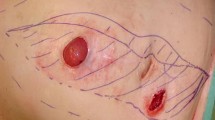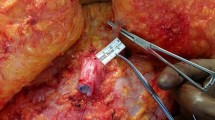Abstract
The repair of giant abdominal hernias in high-risk obese patients remains a great challenge. There is no single simple surgical procedure to provide correction for this condition, and the risk for recurrence of hernia is high. Moreover, the insertion of a foreign material, i.e., synthetic mesh, adds an increased risk of infection, particularly in the presence of concomitant immunosuppressant therapy or diabetes. Eight patients, classified ASA 3–4, with giant abdominal wall hernias had 3 months pre-treatment with a custom-made compressive garment before abdominal wall repair. Four patients had a stoma at the time of surgery. Abdominal wall reconstruction was undertaken by realignment of the rectus muscles and fascia under tension. The fascia repair was stabilized with a full-thickness skin overlay graft. Early complications included two wound infections and one seroma. Two patients had pulmonary insufficiencies and required intensive care management. One complete recurrence of hernia was noted at follow-up. Full-thickness skin overlay grafts can be recommended in high-risk patients with abdominal wall hernias when the use of foreign material such as synthetic mesh is contraindicated.




Similar content being viewed by others
References
Downey SE, Morales C, Kelso RL, Anthone G (2005) Review of technique for combined closed incisional hernia repair and panniculectomy status post-open bariatric surgery. Surg Obes Relat Dis 1(5):458–461
Espinosa-de-Los-Monteros A, de la Torre JI, Ahumada LA, Person DW, Rosenberg LZ, Vasconez LO (2006) Reconstruction of the abdominal wall for incisional hernia repair. Am J Surg 192(2):173–177
Flier S, Knape JT (2006) How to inform a morbidly obese patient on the specific risk to develop postoperative pulmonary complications using evidence-based methodology. Eur J Anaesthsiol 23(2):154–159
Holton LH III, Kim D, Silverman RP, Rodriguez ED, Singh N, Goldberg NH (2005) Human acellular dermal matrix for repair of abdominal wall defects: review of clinical experience and experimental data. J Long Term Eff Med Implants 15(5):547–558
Jacobsen WM, Petty PM, Bite U, Johnson CH (1997) Massive abdominal-wall hernia reconstruction with expanded external/internal oblique and transversalis musculofascia. Plast Reconstr Surg 100(2):326–335
Kama NA, Coskun T, Yavuz H, Doganay M, Reis E, Akat AZ (1999) Autologous skin graft, human dura mater and polypropylene mesh for the repair of ventral abdominal wall hernias: an experimental study. Eur J Surg 165:1080–1085
Korenkov M, Sauerland S, Arndt M, Bograd L, Neugebauer EA, Troidl H (2002) Randomized clinical trial of suture repair, polypropylene mesh or autodermal hernioplasty for incisional hernia. Br J Surg 89:50–56
Lucas CE, Ledgerwood AM (1998) Autologous closure of giant abdominal wall defects. Am Surg 64:607–610
Millard R, Pigott R, Zies P (1969) Free skin grafting of full-thickness defects of abdominal wall. Plast Reonstr Surg 43(6):569–582
Navarrini GC, Russo C, Armaroli R, Guerzoni AP (1987) Skin grafts in the surgical treatment of incisional hernias. It J Surg Sci 17(1):49–53
Ramirez OM, Ruas E, Dellon AL (1990) “Components separation” method for closure of abdominal-wall defects: an anatomical and clinical study. Plast Reconstr Surg 86:519–526, 1990
Samson TD, Buchel EW, Garvey PB (2005) Repair of infected abdominal wall hernias in obese patients using autologous dermal grafts for reinforcement. Plast Reconstr Surg 116(2):523–527
Saurland S, Korenkov M, Kleinen T, Arndt M, Paul A (2004) Obesity is a risk factor for recurrence after incisional hernia repair. Hernia 8:42–46
Schutter FW, Kiroff P (1995) Mesh reinforced cuti-plasty. Langenbecks Arch Chir 380(5):249–252
Shestak KC, Edington HJD, Johnson RR (2000) The separation of anatomic components technique for the reconstruction of massive midline abdominal wall defects: anatomy, surgical technique, applications, and limitations revisited. Plast Reconstr Surg 105:731–738
Vargo D (2004) Component separation in the management of the difficult abdominal wall. Am J Surg 188(6):633–637
Williams JK, Carlson GW, deChalain T, Howell R, Coleman JJ (1998) Role of tensor fasciae latae un abdominal wall reconstruction. Plast Reconstr Surg 101(3):713–718, 1998
Author information
Authors and Affiliations
Corresponding author
Rights and permissions
About this article
Cite this article
Strigård, K., Stark, B. Repair of giant abdominal wall hernias with full-thickness skin transplants in high-risk patients. Eur J Plast Surg 31, 21–24 (2008). https://doi.org/10.1007/s00238-008-0213-7
Received:
Accepted:
Published:
Issue Date:
DOI: https://doi.org/10.1007/s00238-008-0213-7




